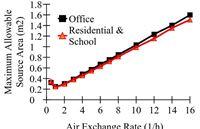Modeling the Effectiveness of Flush-out Procedures in Reducing Formaldehyde in New Building Construction

This research explores the effectiveness of the flush-out procedure and the inferred limits to the amount of off-gassing materials that can be included in new construction. The project used a first order emission decay model to iteratively determine the maximum allowable source emitting areas that could be present at the start of the flush-out procedure and still meet recommended concentration limits for formaldehyde from two engineered wood products. Modeling included residential, school, and office scenarios to determine a range of allowable source areas. These results varied with changes in air exchange rates, material emissions characteristics, and ceiling heights. In most cases the modeled indoor air concentration of formaldehyde was calculated to be below the recommended limit when using typically expected source areas in each of the three scenarios.
keywords: indoor air quality, flush-out, formaldehyde, LEED, modeling


Add comment
Log in to post comments